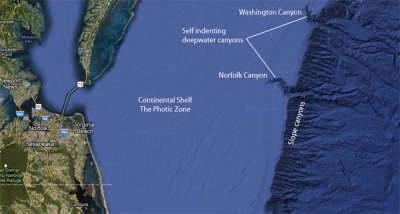New Atlantic drilling protections don’t extend to much of Southeast
The Obama administration announced yesterday that it will permanently protect 3.8 million acres of the Atlantic Ocean from oil and gas development, removing 31 Atlantic canyons from any offshore drilling activity. But to the disappointment of coastal communities and businesses in the Southeast, the new protections do not extend south of Norfolk Canyon off the coast of Virginia.
Norfolk Canyon is part of a large swath of the Atlantic protected from offshore drilling under new protections announced by the federal administration. 
Norfolk Canyon
Earlier this year, following strong opposition from coastal communities and businesses, the administration scrapped a controversial plan to open the Atlantic Ocean from Virginia to Georgia to offshore drilling. And, while yesterday’s announcement adds extra protection for these specific Virginia areas, opposition to drilling anywhere in the Southeast has only grown stronger in recent months.
“There is no question this is encouraging news for this important area off the coast of Virginia, yet the rest of the Southeast coast is just as environmentally and economically valuable and deserving of protection,” said Sierra Weaver, leader of SELC’s coast and wetlands program. “The message from coastal communities and businesses could not be louder or clearer: we do not want offshore drilling. Not just for the next five years but for all time.”
More than 120 coastal cities and towns from New Jersey to Florida and hundreds of businesses, trade groups, and tourism associations have passed resolutions opposing Atlantic drilling and seismic testing. Just last week, the Business Alliance for Protecting the Atlantic Coast, representing over 35,000 businesses and 500,000 commercial fishing families, asked the Obama administration to permanently protect all Atlantic waters.
“The good news is that the water off of Virginia and north are largely protected from offshore drilling,” said Frank Knapp, co-founder of BAPAC and President/CEO of the South Carolina Small Business Chamber of Commerce. “The bad news is that this area represents far less than 10 percent of the total Atlantic coastal area oil companies might want to drill in the future. The coastal communities from North Carolina down to Florida are still at risk for the devastation of seismic testing and drilling for oil. This is very disappointing.”
“While this decision provides important protections for some valuable marine areas, the opposition to offshore drilling stretches far beyond those places,” said Weaver. “Local communities will continue to fight to protect the entire coast.”
The decision to remove the Atlantic Ocean from the federal five-year leasing plan earlier this year also reflected concerns from the Department of Defense about how drilling would impact military activities, as well as economic concerns about the risks to tourism and fishing. Even without a catastrophic accident, the industrialization and infrastructure associated with drilling—the rigs, refineries, pipelines, and traffic—would irreparably change coastal communities and the thriving tourism economy.
The Southeast Coast, which has never seen industrial gas development, is home to dozens of National Wildlife Refuges, National Seashores, and ecologically important marine areas—including the areas now protected from seismic testing, used to survey the ocean floor for oil and gas deposits. Local communities have opposed seismic testing as a prelude to the drilling they’ve rejected, while also voicing concerns about its significant impacts on marine life.
“Up to this point, the process has clearly reflected the will of the people,” said Weaver. “Any future attempt to open this area to drilling will go against the hundreds of communities, thousands of businesses, and millions of residents that have spoken out against gambling with their coasts.”
